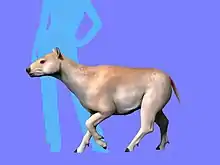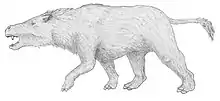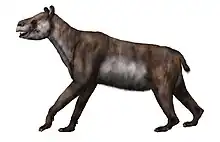| Moqueguahippus | |
|---|---|
| Scientific classification | |
| Domain: | Eukaryota |
| Kingdom: | Animalia |
| Phylum: | Chordata |
| Class: | Mammalia |
| Order: | †Notoungulata |
| Family: | †Notohippidae |
| Genus: | †Moqueguahippus Shockey et al. 2006 |
| Species: | †M. glycisma |
| Binomial name | |
| †Moqueguahippus glycisma Shockey et al., 2006 | |
Moqueguahippus is an extinct genus of notohippid notoungulates that lived during the Late Oligocene of what is now Peru. Fossils of this genus have been found in the Moquegua Formation of Peru, which it was named after.[1][2]
Etymology
The genus name, Moqueguahippus, refers to the Moquegua Formation where it was discovered, and -hippus meaning "horse", an epithet used to describe most notohippids. The specific name, glycisma, is derived from the Greek word Glykisma, meaning "cake", in reference to the type locality, Pan de Azucar, meaning "Sugarloaf Mountain".[1]
Description
Moqueguahippus is a relatively large notohippid. Its skull was rather massive and had a short muzzle. The dentition was complete and continuous, lacking a diastema, and the premolars and molars were high-crowned (hypsodont), like in its relative Rhynchippus. The premolars had a well developed cingulum, while the molars were elongated. The shape of the premolars and molars was reminiscent to those of Equidae. Moqueguahippus, like its relatives, may have had a robust body with slender limbs. Its most peculiar distinctive characteristics were the cup-shaped internal cingula and the lack of cingula on the premolars, and a thick layer of cementum.[1][3]
Taxonomy
Moqueguahippus was first described in 2006, based on fossilized remains found in the Moquegua Formation in Peru, in deposits dating to the Late Oligocene. Moqueguahippus was placed within the family Notohippidae, a family of toxodont notoungulates with horse-like teeth, with very high-crowned molars. More recent research, however, suggests that this group is paraphyletic, containing increasingly derived forms, some of them close to the ancestors of "true" Toxodontidae. In 2021, it was found to be a derived notohippid, being the sister taxon of a clade including the Miocene genera Argyrohippus and Notohippus.[4]
The following position of the Toxodontia is based on Martínez et al. 2021, showing the position of Moqueguahippus.[4]
| Toxodontia |
|
"Isotemnidae" Paranotohippids "Isotemnidae" "Notohippidae" | |||||||||||||||||||||||||||||||||||||||||||||||||||||||||||||||||||||||||||||||||||||||||||||||||||||||||||||||||||||||||||||||||||||||||||||||||||||||||||||||||||||||||||||||||||||||||||||||||||||||||||||||
References
- 1 2 3 Shockey, Bruce J.; Salas, Rodolfo; Quispe, Rossana; Flores, Alexander; Sargis, Eric J.; Acosta, Jorge; Pino, Adan; Jarica, Nestor J.; Urbina, Mario (2006-03-30). "Discovery of Deseadan fossils in the upper Moquegua Formation (late Oligocene—?early Miocene) of southern Peru". Journal of Vertebrate Paleontology. 26 (1): 205–208. doi:10.1671/0272-4634(2006)26[205:DODFIT]2.0.CO;2. ISSN 0272-4634. S2CID 85593383.
- ↑ Shockey, Bruce J.; Gismondi, Rodolfo Salas; Gans, Phillip; Jeong, Annie; Flynn, John J. (2009). "Paleontology and Geochronology of the Deseadan (late Oligocene) of Moquegua, Perú". American Museum Novitates (3668): 1–24. doi:10.1206/662.1. ISSN 0003-0082.
- ↑ Cerdeño, Esperanza; Vera, Bárbara (2014-06-07). "New data on diversity of Notohippidae from the Oligocene of Mendoza, Argentina". Journal of Vertebrate Paleontology. 34 (4): 941–950. Bibcode:2014JVPal..34..941C. doi:10.1080/02724634.2014.837054. hdl:11336/32354. ISSN 0272-4634. S2CID 85991987.
- 1 2 Martínez, Gastón; Dozo, María T.; Gelfo, Javier N.; Ciancio, Martín R.; González-José, Rolando (2021-02-11). "A new toxodont (Mammalia, Panperissodactyla, Notoungulata) from the Oligocene of Patagonia, Argentina, and systematic considerations on the paraphyletic 'Notohippidae'". Journal of Systematic Palaeontology. 18 (24): 1995–2013. doi:10.1080/14772019.2021.1872723. ISSN 1477-2019. S2CID 232116246.
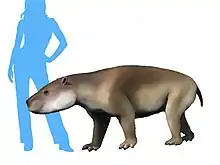
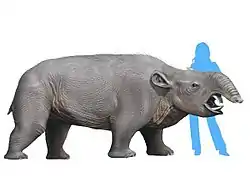

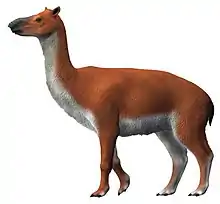
.jpg.webp)
